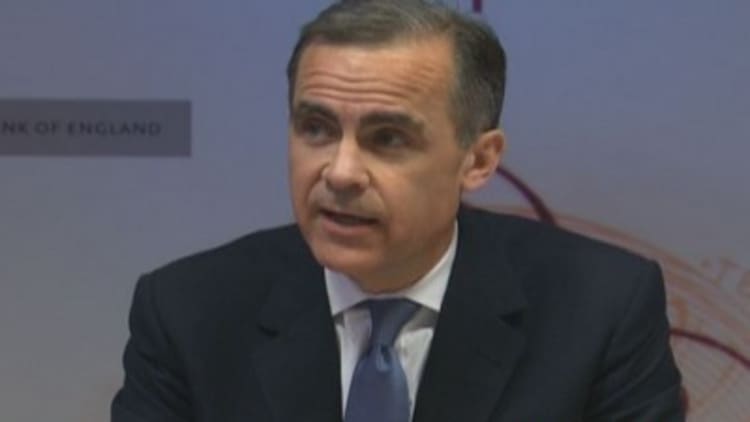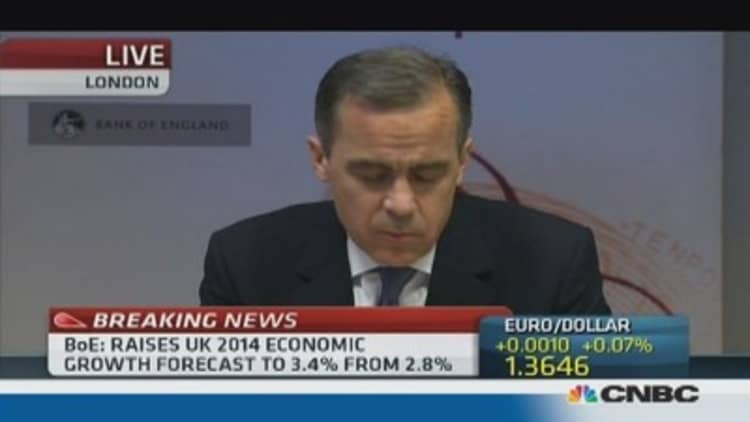
Bank of England Governor Mark Carney unveiled the "next phase" of forward guidance and adopted a less dovish tone than many expected at the central bank's quarterly update on economic forecasts.
Carney was driven to revise the guidance - which initially tied the bank rate to the country's unemployment rates - after a sharp fall in jobless numbers took the central bank by surprise.
The bank also sharply revised up its growth forecasts for the U.K. economy in 2014, and revised down its inflation forecast. The central bank now expects gross domestic product growth of 3.4 percent this year - substantially higher than its earlier forecast of 2.8 percent.
(Read more: Forward guidance shift? All eyes on Mark Carney)
This optimistic outlook, combined with comments from Carney that were less dovish than some had anticipated, boosted expectations that the Bank of England could hike interest rates in just over a year's time.
Sterling rose 0.6 percent against the dollar as Carney spoke at a press conference following the release of the central bank's Inflation Report. Meanwhile yields on the U.K.'s 10-year benchmark gilt rose sharply to 2.799 percent after starting the session at 2.75 percent.
After the Bank of England left monetary policy unchanged last week, Carney said on Wednesday there was still "scope" to absorb spare capacity in the U.K. economy, indicating that rates would not be raised from their record low of 0.5 percent in the near future.
"If and when the time comes that the economy can sustain higher interest rates, bank rate is expected to rise only gradually," Carney said in a statement.
"For a sustained and balanced recovery, the degree of stimulus will need to remain exceptional for some time."
But despite these comments, Samuel Tombs, U.K. economist at Capital Economics, said markets were still expecting a rate hike in the second quarter of 2015.
"Carney was certainly less dovish, moving the emphasis to how quickly the bank rate will rise rather than when it will," he told CNBC.
Kathleen Brooks, research director of Forex.com, agreed.
"Carney was not dovish enough for the markets; the Bank of England did not revise the economic threshold directly, and did not seem as committed to keeping rates at the current 0.5 percent level for the long term," she said in a note.
The Bank of England said that even when rates started to rise, they would remain "materially lower" than before the onset of the crisis - when they were around 5 percent.
Vague guidance?
In a surprise to some analysts, Carney's "second phase" of forward guidance did not link a rate hike to any specific indicators.
Instead, he said the bank's monetary policy committee (MPC) would be "monitoring a broad range of indicators" including labor market participation, average hours worked, productivity, and wages. The bank will also publish forecasts of 18 more economic indicators for the first time.
(Read more: Exports and investment to boost UK recovery)
In August, Carney announced that interest rates would not be raised until the rate of unemployment in the U.K. hit 7 percent - which it did not expect to happen for three years.
Since this unveiling of forward guidance - which marked a significant departure by Carney from the reign of his predecessor, Mervyn King – joblessness has fallen much faster than expected, sliding to 7.1 percent in the three months to November.

Despite this, Carney insisted on Wednesday that unemployment was the "right metric" for the first phase of forward guidance, arguing that "it worked."
(Read more: UK economy records fastest growth in 6 years)
The bank now expects unemployment to have hit its 7 percent target in the three months in January, and to continue to fall to 6.5 percent early 2015.
"We've learned as we went along the way, we didn't expect to be here at this point in time," Carney added at the press conference.
Brooks said that after a couple of "less than inspiring" performances, Carney had succeeded in providing the markets with some clarity with regards to its economic outlook.
But she expressed concerns about the vague nature of the the second phase of forward guidance.
"The Bank of England may not raise rates until the MPC feels in its gut that rates need to be increased, and markets are notoriously bad at reading a central bank's gut feeling," she said.
While Tombs added: "Forward guidance has just become a whole lot fuzzier, which makes it harder for both firms and households to know when a rate hike is coming."
—By CNBC's Katrina Bishop. Follow her on Twitter @KatrinaBishop and Google


